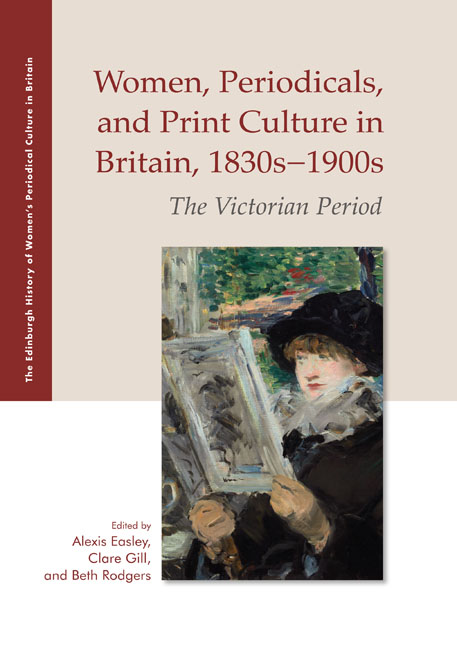Book contents
- Frontmatter
- Contents
- List of Illustrations
- Acknowledgments
- Introduction: Women, Periodicals, and Print Culture in the Victorian Period
- Part I (Re)Imagining Domestic Life
- (Re)Imagining Domestic Life: Introduction
- 1 The Rise and Rise of the Domestic Magazine: Femininity at Home in Popular Periodicals
- 2 Regulating Servants in Victorian Women's Print Media
- 3 Women Editors’ Transnational Networks in the Englishwoman's Domestic Magazine and Myra's Journal
- 4 Women and Family Health in the Mid-Victorian Family Magazine
- 5 Negotiating Female Identity in Nineteenth-Century Ireland
- 6 Women and the Welsh Newspaper Press: The Cambrian News and the Western Mail, 1870–1895
- Part II Constructing Modern Girls and Young Women
- Part III Women and Visual Culture
- Part IV Making Space for Women
- Part V Constructing Women Readers and Writers
- Part VI Intervening in Political Debates
- Notes on Contributors
- Index
- Plate section
1 - The Rise and Rise of the Domestic Magazine: Femininity at Home in Popular Periodicals
from Part I - (Re)Imagining Domestic Life
Published online by Cambridge University Press: 25 October 2019
- Frontmatter
- Contents
- List of Illustrations
- Acknowledgments
- Introduction: Women, Periodicals, and Print Culture in the Victorian Period
- Part I (Re)Imagining Domestic Life
- (Re)Imagining Domestic Life: Introduction
- 1 The Rise and Rise of the Domestic Magazine: Femininity at Home in Popular Periodicals
- 2 Regulating Servants in Victorian Women's Print Media
- 3 Women Editors’ Transnational Networks in the Englishwoman's Domestic Magazine and Myra's Journal
- 4 Women and Family Health in the Mid-Victorian Family Magazine
- 5 Negotiating Female Identity in Nineteenth-Century Ireland
- 6 Women and the Welsh Newspaper Press: The Cambrian News and the Western Mail, 1870–1895
- Part II Constructing Modern Girls and Young Women
- Part III Women and Visual Culture
- Part IV Making Space for Women
- Part V Constructing Women Readers and Writers
- Part VI Intervening in Political Debates
- Notes on Contributors
- Index
- Plate section
Summary
Whatever differences of opinion may exist upon a thousand and one different subjects of modern discussion; there can be little doubt that this is an age of much writing, printing and publishing.
(Englishwoman's Domestic Magazine 1 Apr 1861: iii)SO WROTE SAMUEL BEETON as he launched the new series of his Englishwoman's Domestic Magazine in 1861. As publisher, editor, and writer for the periodical press, Beeton was a major contributor to the flood of print he described. The new series he was introducing with these words was a larger, more expensive, and more fashion-oriented version of the magazine he had founded nine years earlier and which may be taken as marking the confident arrival of the domestic magazine as a publishing genre.
Such a statement begs many questions. Recent scholarship across a range of disciplines has struggled with the complex meanings of ‘home’ and the ‘domestic’ and how they relate to femininity (Flanders 2015; Mallett 2004). These debates inform my chapter but are not the object of my study, which is focused on the emergence of the particular genre within British periodical publishing which simultaneously addressed the ‘domestic woman’ and sought to bring her into being. Though the meaning of the domestic has become the subject of academic journals, it is in the pages of the magazines read by the ‘ordinary’ woman at home where those debates were and are worked through in that complex interweaving of materiality, emotion, and ideology in which we all struggle to give meaning to our lives. Both the meaning of home/the domestic and the form of the magazine shift through time. Still, the link between ‘femininity’ and ‘home’ has remained surprisingly resilient, and ever since its emergence in the midnineteenth century, the ‘domestic magazine’ has also persisted as the site of negotiations around that relationship.
What then constituted a ‘domestic magazine’ in the 1850s and 1860s? What distinguished it from other sorts of periodicals and was it a new publishing genre? In his pioneering essay on the need to produce a directory of Victorian periodicals, Michael Wolff described that press as a ‘golden stream’ (1971: 23).
- Type
- Chapter
- Information
- Women, Periodicals and Print Culture in Britain, 1830s–1900sThe Victorian Period, pp. 18 - 31Publisher: Edinburgh University PressPrint publication year: 2019

